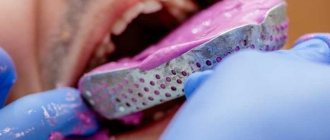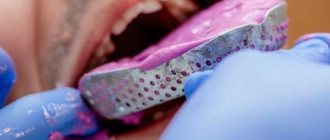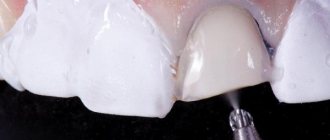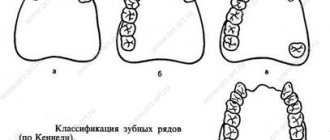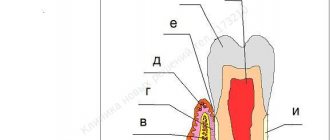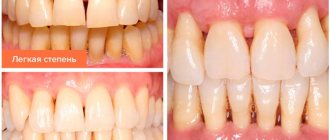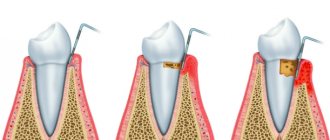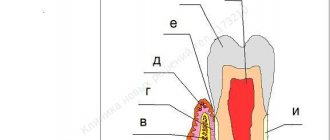Prevention
- Primary: prevention of dental diseases by eliminating the causes and conditions of their occurrence, as well as increasing the body’s resistance to adverse factors.
- Secondary: a set of measures aimed at preventing relapses and complications of diseases.
- Tertiary: a system of measures aimed at the rehabilitation of dental status by preserving the functionality of organs and tissues of the maxillofacial area, mainly by replacement.
Preventive measures are beneficial to everyone without exception. They are especially needed by patients suffering from endocrine diseases, pregnant women, and people with bad habits.
Primary prevention of periodontal disease involves
- training in the basics of individual oral hygiene, monitoring the quality of its implementation;
- carrying out professional hygienic treatment of the oral cavity at certain intervals;
- elimination of violations of the architectonics of the soft tissues of the vestibule of the oral cavity, abnormal attachment of cords and frenulum (short cords and frenulum, small vestibule of the oral cavity);
- according to indications - timely orthodontic treatment in order to normalize the distribution of mechanical load on the teeth and at the same time - eliminate the conditions in which the activity of microbial influences increases.
It is primary prevention, its timely initiation and implementation on the required scale that allows us to solve the problem of periodontal diseases. Secondary and tertiary prevention are always strictly individual and depend on the existing consequences of the disease.
Types of periodontal diseases and their main symptoms
- Gingivitis is an inflammation of gum tissue caused by pathogenic microflora. It is characterized by swelling and redness of the gums, bleeding, bad breath, and sometimes erosion.
- Periodontitis is an inflammation of the periodontal tissues, leading to the destruction of the dental joint. Accompanied by bleeding and inflammation of the gums, pain when pressing, unpleasant odor from the mouth, and mobility of teeth.
- Periodontal disease is a degenerative disease of the periodontal tissues, leading to impaired nutrition and blood supply to the tissues and, as a consequence, to their subsequent destruction with tooth loss. Pathological changes are characterized by a chronic course. First, there is discomfort in the oral cavity, then the gums become inflamed and begin to bleed and hurt, the teeth become mobile, the bite may change, and bad breath appears.
- Desmondontosis, histiocytosis X, Papillon-Lefevre syndrome are idiopathic diseases that cause the destruction of all periodontal tissues. As a result, displacement and subsequent loss of teeth occurs. The diseases may be accompanied by inflammation, pain and bleeding of the gums, as well as the appearance of purulent discharge from periodontal pockets.
- Tumor-like neoplasms in periodontal tissues (fibroma, gingival fibromatosis, lipoma, epulide). They are round or mushroom-shaped formations on the gums (epulides), and can also be in the form of a roller around the crown of the tooth (gingival fibromatosis). They can lead to resorption of the interdental septa and the alveolar ridge.
In most cases, at the initial stage, periodontal disease, leading to the destruction of soft tissues and bones, is painless and without pronounced symptoms.
Oral hygiene
Individual oral hygiene is the main method of primary prevention of periodontal diseases:
- regular and proper brushing of teeth (3 times a day);
- using high-quality toothbrushes and toothpastes;
- the use of additional means of prevention (flosses, interdental brushes, irrigators, devices for cleaning the tongue, etc.).
Factors in choosing personal hygiene products
- age;
- the presence of dental diseases or a predisposition to them;
- individual characteristics of the oral cavity (atypical structure of the dentition and shape of the teeth, the presence of orthopedic or orthodontic structures in the oral cavity, etc.).
Prevention of hypersensitivity of dental tissues
About 62% of the adult population in Russia suffers from painful tooth sensitivity. Most often, increased sensitivity occurs when the necks of teeth are exposed due to periodontal disease. In addition, it can cause the development of periodontal diseases due to unsatisfactory tooth brushing due to the pain of its implementation. Special toothpastes, rinses, flosses and gels are used as therapeutic and prophylactic agents for increased dental hypersensitivity.
Elimination of local factors
A number of local factors contribute to increased accumulation of dental plaque. There are a number of such factors: cervical carious cavities; unrestored interdental contacts; overhanging edges of fillings; edges of artificial crowns deeply advanced under the gum; foci of demineralization of gingival surfaces; lack of equator of tooth crowns; wide and attached close to the gingival edge of the frenulum and strands of the mucous membrane; availability of orthodontic devices; close arrangement of teeth, etc. Therefore, timely elimination of the listed factors is a necessary component of the prevention of inflammatory periodontal lesions.
Elimination of supercontacts and functional selective grinding
The traumatic factor is one of the most significant. In the absence of physiological abrasion of the enamel tubercles, which is observed in 20-22% of the population, in order to prevent increased and uneven load on the periodontium, functional selective grinding is carried out.
Surgical elimination of deformation of the soft tissues of the oral vestibule
Correction of pulling cords, frenulums, and small vestibule of the oral cavity should be carried out before they have time to lead to destructive lesions. The optimal period is the school period, after the completion of the formation of the alveolar process.
Bite correction
Malocclusion affects the condition of the periodontium, usually due to uneven mechanical load on the periodontium. Therefore, correcting malocclusion in childhood has a significant preventive effect.
Prophylactic use of antiseptic drugs
When carrying out preventive measures, it is necessary to use antimicrobial drugs that affect periodontal pathogenic microflora. Some of the most effective agents are chlorhexidine and triclosan. The use of products containing these substances should be supervised by specialists.
Professional oral hygiene
Professional oral hygiene is an important point in the system of preventing inflammatory periodontal diseases. We use the following tools: scalers, air-abrasive systems (handy blasters), such as Air-Flow (EMS); abrasive polishing pastes.
Prospects for the use of probiotics for the prevention of caries and periodontal diseases in children
Early childhood caries remains the most common chronic childhood disease. Every year, about 1.8 billion new cases are registered worldwide. Already in three-year-old children, dental caries damage can reach 32%. Oral health affects the general condition of the body and the quality of life of the child. Long-term pathological processes, especially during the period of growth and development of the dental system, lead to disruption of the formation of dental tissues and early destruction of the periodontal complex. In the modern etiology of caries, the leading role is given to cariogenic microflora. In addition, the level of dental knowledge of parents, their commitment to preventive visits and treatment of temporary teeth are important. Based on a review of the literature, it was established that in order to prevent and treat caries and periodontal diseases, it is important to use preparations with live probiotic bacteria that produce salivarcins. These are antibacterial substances that inhibit the growth of oral pathogens. However, in Russia, most studies are devoted to the study of intestinal probiotics (lacto- and bifidobacteria), which increase the concentration of secretory immunoglobulin A. Clinical studies of probiotics used as an addition to daily oral care are needed.
One of the pressing problems of modern dentistry is dental caries in young children [1]. Against the background of a dysbiotic state of oral microorganisms, mainly caused by a diet rich in sugar, poor oral hygiene and insufficient plaque removal, caries progresses rapidly. In addition to tooth decay, discomfort and pain, the quality of life decreases. Children at high risk of developing caries may subsequently experience occlusion of the dentition, problems with diction, etc. [2].
Currently, significant progress has been made in studying the etiology and pathogenesis of dental caries. The generally accepted mechanism of its development is the progressive demineralization of hard dental tissues under the influence of organic acids, the formation of which is associated with the activity of certain microorganisms.
The oral flora includes more than 700 species/taxa of bacteria [3]. Many bacteria are known to regulate their cooperative activities and physiological processes through a mechanism called quorum sensing, in which bacterial cells interact with each other in response to small, diffusible signaling molecules. Due to their ability to interact closely, bacteria have significant advantages in host colonization, biofilm formation, protection from competitors, and adaptation to changing conditions. For example, dental plaque is a biofilm community characterized by biodiversity and high cell density. All this, combined with environmental fluctuations, inevitably leads to intra- and interspecific interactions. The interactions between oral bacteria have been well studied. For example, bacterial coaggregation promotes the coadhesion of bacterial pairs to the tooth surface, nutritional synergy and complementation ensure cell growth in saliva, and food chains are formed through metabolic cooperation between several species. This cooperative interaction plays a very important role in the development of dental biofilms.
In addition, competition or antagonistic interspecies relationships may be equally important in maintaining the balance between microbes in dental biofilms, as well as between dental biofilms and host defense mechanisms in the oral cavity. Many bacteria in dental biofilms produce peptide bacteriocins, which play important roles in interspecific competition, biodiversity, and microbial ecological fitness.
Numerous studies have shown that the production of bacteriocins by transformable streptococci such as Streptococcus mutans
,
Str .
gordonii ,
S tr.
sanguinis and
S tr.
mitis , is strictly controlled by the quorum sensing system, which also regulates genetic competence and biofilm formation in these species. Interestingly, all of these species are considered to be major colonizers of dental biofilms, although bacteriocins produced by one species kill other species. Such interactions balance competition and coexistence of organisms in a microbial community such as dental biofilm, maintaining microbial biodiversity and homeostasis within the same ecosystem. Many quorum-controlled activities influence the virulence and pathogenic potential of bacteria. Thus, understanding the molecular mechanisms of quorums and their activity may open new possibilities for combating bacterial infections [4].
Among cariogenic microorganisms, the leading role is given to streptococci of the “mutans” group as the most acid-forming representatives of oral streptococci. In addition, one of the most important biological properties of Str. mutans
is its ability to attach to the smooth surface of teeth, which ensures the formation of cariogenic dental plaque [1].
When analyzing the results of a study of microbiocenosis of dental biofilm in young children with dental caries, the main cariogenic species Str. mutans
was isolated in 70% of cases.
The level of its contamination was 5.48 ± 0.29 (about 105 CFU/ml). The level of contamination with another cariogenic species Str. was even higher . sangui nis
– 7.06 ± 0.24 (about 107 CFU/ml). It was isolated from 100% of patients.
Among the periodontopathogenic species of anaerobic bacteria, the virulent species Prevotella intermedia
(46.7%), somewhat less frequently (30%) - a representative of the main periodontopathogenic species
Porphyromonas gingivalis
.
Other periodontopathogenic and virulent species – Fusobacterium
spp.
and Klebsiella
spp.
were found in 13.3% of children. Actinobacillus actinomycetemcomitans
,
Bacteroides forsythus
and
Treponema denticola
were not detected.
Candida albicans
were found in significant quantities (5.14 ± 0.25) [4].
The dental status of a child depends on the level of oral hygiene, the prevalence of dental caries, the presence of inflammation of periodontal tissue and a number of other factors.
Young children usually have a negative attitude towards visiting the dentist and show anxiety during dental procedures. Ultimately, tooth loss leads to impaired speech development, psychological discomfort, and decreased quality of life [5].
The perception of basic rules of oral hygiene in childhood depends on the parents. Not only dental knowledge is important, but also cultural beliefs, awareness of nutrition and feeding practices, and one’s own oral hygiene habits.
It has been established that children of parents who have a positive attitude towards dental care, who regularly undergo preventive examinations, have better dental health. From the above, it follows that interventions aimed at changing parents’ beliefs and practices regarding children’s oral health can prevent problems in the future [6].
The results of a number of studies show that parental education influences the choice of hygiene products for oral care at home, the frequency of tooth brushing and its control [6, 7]. People with a low socio-economic level, who do not have educational information about oral health, seek dental care only if the child has acute pain, ignore regular preventive examinations, believing that baby teeth are temporary. Children from such families have a high prevalence of caries.
As correlation analysis has shown, parents’ assessment of the condition of children’s primary teeth is, as a rule, overestimated and does not correspond to the real state of affairs [8].
174 parents participated in the study of Volgograd dentists. When answering the question whether your child uses additional oral hygiene products, the majority of respondents named only the basic products - toothpaste and toothbrush (64.9%). The survey revealed that children do not use additional oral hygiene products enough. The majority of parents (47.7%) change their children's toothbrush once every two to three months, 18.4% - once a month, 2.2% - once every six months, 5.2% - once a year. 6.9% of respondents found it difficult to answer. According to the results of the survey, parents are not sufficiently informed about the proper teeth brushing regimen. Only 19.0% of children brush their teeth rationally, namely twice a day – in the morning after breakfast and in the evening before bed [9].
Survey data from 107 parents demonstrated an insufficient level of knowledge regarding the prevention of dental diseases in preschool children. 13.7% of patients aged three to four years and 9.1% of children aged five to six years old go to the dentist with pain. 50–61.9% of parents perform oral hygiene for children regularly twice a day. Most parents do not pay attention to the composition of children's toothpaste. 63.6–80.9% of parents receive information from the dentist [10].
A number of other countries also report low levels of parental health literacy. In an Italian study (2019), parents of 101 children were interviewed. Data analysis showed that only 24% of respondents are aware of the potentially dangerous transmission of cariogenic bacteria through saliva when hygiene rules are ignored, 61% of parents continue to try their child’s food. Of 101 children, 30% use a pacifier for more than a year, 17% use a bottle of milk at night. Moreover, in 41% of cases the children were over two years old. Parents report that 57% of children do not brush their teeth in the first three years of life [11].
Of interest are the results of an Indian study, according to which parents with higher education consider it necessary to brush their teeth and undergo preventive examinations at the dentist. According to 42.1% of mothers with secondary education, regular teeth brushing is necessary to prevent caries. 14% of respondents believe that brushing your teeth prevents bad breath. 80% of parents with only a high school education agree that their children should have regular dental checkups, 10% disagree, and 10% don't even know about it. Among mothers who received a diploma/degree, 81.9% agreed, 12.8% and 5.3% disagreed [12].
Today, there is an integration of motivational interviewing aimed at increasing health education about the prevention of dental caries in children, parental literacy, and children’s adherence to hygiene procedures [13]. This technique consists of a special format of conversation between a doctor and a patient about daily oral care and includes questions about the child’s and parents’ knowledge of basic hygiene rules and willingness to change daily habits in order to improve oral hygiene. The technique also involves receiving feedback from the patient, summing up the results, and supporting the doctor for the child and parents who want to change approaches to maintaining oral hygiene rules [14].
Information about parents' awareness of the prevention of dental diseases can become the basis for developing a treatment plan and recommendations. In addition, these data are useful for implementing preventive programs to improve oral health in children with caries [15].
For successful treatment and prevention of caries, anti-caries drugs are needed to restore the balance of the oral microbiome [16]. The World Health Organization defines probiotics as “live microorganisms that, when used in recommended amounts, confer a health benefit on the host.” The influence of probiotics on human health has been proven [17]. Unlike other food or drug ingredients, live probiotics have in situ
[18]. Probiotics are involved in maintaining oral health by interacting with the microbiome and helping to stabilize microbial balance. The nature and composition of any individual microbiome influences overall health.
The main processes that provide the beneficial effects of probiotics include:
- inhibition of the growth of potentially harmful microorganisms as a result of the production of antimicrobial substances and activation of immunocompetent cells;
- stimulation of growth of representatives of microflora as a result of the production of vitamins and other growth-stimulating factors;
- neutralization of toxins and normalization of pH;
- changes in microbial metabolism, manifested in an increase or decrease in enzyme activity [19].
Drug resistance and side effects of available antimicrobials limit their use as preventive therapy. New opportunities for the prevention of oral diseases are associated with the use of probiotics that regulate microbiota [20]. Probiotics do not cause side effects. It is no coincidence that bacteriotherapy using probiotic strains with an inhibitory effect on pathogenic microorganisms of the oral cavity is considered as a promising concept, especially in childhood [21].
Initially, intestinal probiotics were used. However, these strains have certain limitations in terms of their colonization in oral tissues. Scientists have addressed this problem by developing a new generation of probiotic strains isolated from the oral microbiota and belonging to commensal species with extremely low pathogenic potential [22].
In Russia, the most common bacteria in pediatric practice are lactobacilli (LAB) and bifidobacteria (BB). In a clinical study, the complex of dental rehabilitation for children of early childhood without parental care included the use of baby milk with probiotics based on LAB as a factor that inhibits microbial colonization and increases the concentration of secretory immunoglobulin A. During the study, a decrease in the level of contamination of dental biofilm was noted the main cariogenic flora and the frequency of Str. mutans
by 37.8%.
In addition, the frequency of isolation of cariogenic flora antagonists significantly increased: St r.
salivarius – 100% of cases,
Enterococcus
spp.
– 50%, Veillonella
spp.
– 35.7%, Corinebacterium
spp. – 14.2% of cases [23].
Of particular interest is the isolated probiotic strain M18 Str.
salivarius
, since it produces salivartsins - topical antibacterial substances that can suppress the growth of pathogens of oral infections, namely
Streptococcus
spp.,
Porphyromonas
spp.,
Actinomyces
spp.,
Aggregatibacter
spp. The M18 strain also produces the enzymes dextranase and urease, which reduce plaque accumulation and neutralize oral acidity [24].
The randomized, double-blind, placebo-controlled study involved 100 children with dental caries who received M18 for three months. The effectiveness criteria were changes in the amount of dental plaque, assessment of periodontal indices, as well as the microbiological part. The researchers assessed S tr levels. salivarius
,
Str .
mutans , lactobacilli, beta-hemolytic streptococcus in saliva.
At the end of treatment, the number of dental plaques in children decreased significantly, especially in the group with an unsatisfactory oral hygiene index. Analysis of cell cultures and serial saliva samples showed a decrease in the amount of S tr.
mutans , which indicates the anti-caries activity of probiotic preparations M18.
Scientists concluded that S tr.
salivarius M18, when taken regularly orally, normalizes the microbiota of the oral cavity without having a negative effect on the normal flora of the oral cavity [22].
Currently, probiotics producing salivarcins are considered as replacement therapy for dental caries [16].
Since the pathogenesis of caries and periodontal tissue diseases is associated with changes in the composition of the oral microbiome and the formation of biofilms, probiotic strains can be used for the prevention and treatment of gingivitis and periodontitis. As a rule, most children undergo long-term treatment for anomalies of the dental system using fixed appliances. In such a situation, oral hygiene is difficult, including due to insufficient manual skills and lack of motivation of the patient. The result is the accumulation of biofilm on the teeth and its transition from aerobic to anaerobic supragingival and subgingival periodontopathogenic flora, causing inflammatory reactions of periodontal tissues [25].
The small number of publications and inconsistency of data required a new randomized trial [26], in which patients with fixed orthodontic structures took the probiotic S tr. salivarius
M18 as an addition to daily home oral hygiene. The planned course of treatment was three months, whereas in other studies this period was calculated at three weeks [27]. The duration of the course of treatment was determined by microbiological parameters. Positive changes in bacterial composition were observed six weeks after the start of taking the oral probiotic drug. Thus, a three-month course is enough for probiotic strains to gain a foothold in the oral microbiome and demonstrate their effectiveness. It has been shown that probiotic therapy can be used in periodontal diseases [28].
Additionally, an analysis of 12 randomized controlled trials [29] demonstrated that, overall, oral probiotic supplementation improved recognized clinical features of chronic periodontitis such as periodontal pocket depth, bleeding on probing, and epithelial attachment loss. At the same time, the number of main types of periodontal pathogens decreases. Thus, the use of specific strains of probiotic cultures can become a new step in the prevention of caries and inflammatory periodontal diseases in children [30].
Further clinical studies are needed to evaluate the effectiveness of long-term use of probiotics for dental diseases and their effect on the risk of developing caries and inflammatory periodontal diseases in children.
The authors declare no conflict of interest
.
The benefits of our preventative procedures
- special attention to the condition of the oral cavity during pregnancy;
- strengthening gums with the help of professional procedures: therapeutic dressings, applications, coatings.
- individual selection of hygiene products;
- timely detection of the development of gum disease at an early stage, which facilitates the treatment process.
We hope that preventative measures will help you never experience gum disease. However, gum inflammation can occur against the background of certain body conditions:
- stress;
- hormonal changes: puberty, pregnancy, diseases of the internal secretion organs;
- diseases of the endocrine system - high levels of glucose in the blood (diabetes of any type); vascular diseases; gastrointestinal tract;
- problems with the absorption of certain vitamins and microelements;
- the presence of pathogenic microflora in the oral cavity.
In case of suspicion of serious disorders that played a role in the development of gum disease, Kuntsevo specialists give a referral for examination by doctors in other departments. A multidisciplinary approach to each patient allows not only to cope with the symptoms, but also to eliminate the underlying causes.
Kuntsevo dentists guarantee high quality of services provided. We not only relieve our patients of discomfort and relieve inflammation, but also fight the underlying causes that led to the development of the disease, which ensures lasting results and prevention of relapses.
Regular visits to the dentist as periodontal prevention
1. Examination of the oral cavity.
Even if you don’t have dental problems, you should visit the dentist at least once every six months. In this case, during the examination, the doctor can detect the earliest symptoms of pathology of teeth and gums, see overhanging and chipped fillings, determine errors in crowns and bridges, and assess the presence of tartar. The dentist may suggest a session of fissure sealing or tooth remineralization
2. Cleaning from tartar.
When visiting the dentist, you should periodically brush your teeth to remove tartar. In modern clinics, teeth are cleaned quickly and painlessly using ultrasound, so there is no need to be afraid of this procedure. After cleaning teeth from stones, doctors polish the teeth so that plaque does not linger on their surface.
3. Timely treatment by an orthodontist and orthopedist.
If the patient has an incorrect bite, then it is necessary to correct it, since the likelihood of developing periodontal disease or periodontitis in this case is especially high. In the case of occlusion pathology, the distribution of the functional load on the teeth and alveolar processes changes. Risk factors include abnormal attachment of the labial frenulum and shallow vestibule of the oral cavity.
In modern dentistry there are many different methods for correcting dental pathology - these are braces and splinting. Currently, doctors can offer clasp orthopedic structures to suit any budget. If the patient uses removable orthodontic or orthopedic structures, they must be looked after especially carefully. Removable dentures should be washed and brushed daily. You can purchase special tablets for washing and disinfecting such structures.
Prosthetics are also considered to prevent periodontitis.
4. Remineralization of teeth.
To increase the strength of the enamel, your doctor may suggest treating your teeth with calcium and fluoride. This process is called remineralization. At home, you can saturate your teeth enamel with fluoride using special toothpastes and identical rinses. But, of course, professional remineralization is much more effective. Using a brush, a varnish containing high concentrations of fluoride is applied to the dried and clean tooth enamel. This varnish forms a film that, when dissolved, combines with the calcium of the enamel and strengthens it. Dentists advise combining home remineralization with low doses of fluoride with sessions of professional applications.
Healthy eating as a preventive measure for periodontal disease
1. Take coarse “solid” food more often.
To prevent periodontitis and periodontal disease, you need to consume more vegetables and fruits. The menu should not systematically include pureed dishes with a very soft consistency. If there is no solid food in the diet, then the periodontium is deprived of the necessary load. Active chewing is very beneficial. It strengthens the gums, promotes the proper formation and development of the dentofacial apparatus.
2. Avoid eating very hot and very cold foods.
It is known that contrasting temperatures destroy enamel, promoting the formation of cracks. Moreover, very cold and very hot food in itself is also harmful to enamel.
3. Don't forget about vitamins.
Don’t forget about vitamins, preferably natural ones. Therefore, the menu must contain products containing vitamins A, C, B, E. If it is not possible to buy fruits and berries in sufficient quantities, then it is necessary to take vitamins from the pharmacy.
4. There should be no snacks between meals.
If you really want to snack on something, then it is better to stop at a green apple or raw carrots. Buns, sweets, cookies, that is, products containing sugary substances, are dangerous and very harmful to teeth and gums. Therefore, even after eating one toffee or piece of chocolate, it is necessary to brush your teeth and rinse your mouth within the first 5 minutes after the snack.
